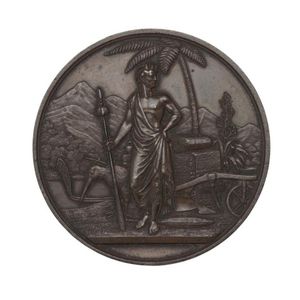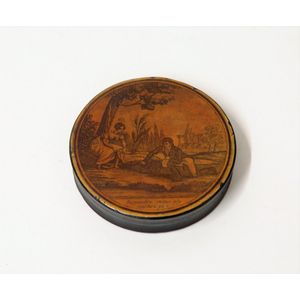Melba's Victorian Silver Tortoiseshell Dish
You must be a subscriber, and be logged in to view price and dealer details.
Subscribe Now to view actual auction price for this item
When you subscribe, you have the option of setting the currency in which to display prices to $Au, $US, $NZ or Stg.
- Tortoiseshell - Tortoiseshell is a translucent material that comes from the horny carapace of a certain types of turtles, including the hawksbill turtle. It is often therefore mounted on a colour underground - often red - or inlaid with gold or silver thread, as seen in Boulle furniture.
The texture and colour nuances of the material are extremely important. Heated tortoiseshell can easily be formed into various shapes. Like other natural materials, tortoiseshell becomes more beautiful with use. In a time before plastic, tortoiseshell was widely used for small objects such as combs and powder compacts.
In 1973, the trade of tortoiseshell worldwide was banned under CITES (The Convention on International Trade in Endangered Species). Prior to importing or exporting items containing tortoiseshell a CITES permit must be obtained. Tortoiseshell items cannot be traded on Ebay.
"Faux tortoiseshell", another case of man initiating nature, is made from old-style plastics such as celluloid and cellulos and is coloured with red, yellow and brown spots to imitate the genuine article. It is commonly used in glasses frames, musical instruments and costume jewellery. - Victorian Period - The Victorian period of furniture and decorative arts design covers the reign of Queen Victoria from 1837 to 1901. There was not one dominant style of furniture in the Victorian period. Designers used and modified many historical styles such as Gothic, Tudor, Elizabethan, English Rococo, Neoclassical and others, although use of some styles, such as English Rococo and Gothic tended to dominate the furniture manufacture of the period.
The Victorian period was preceded by the Regency and William IV periods, and followed by the Edwardian period, named for Edward VII (1841 ? 1910) who was King of the United Kingdom and the British Dominions and Emperor of India for the brief period from 1901 until his death in 1910.
This item has been included into following indexes:
Visually similar items

Len Castle, stoneware dish, of rectangular form with ash glaze and impressed decoration to the well, incised initials to the base. Length 30 cm

A Tibetan cloisonne and black lacquer circular tray, decorated with an ancient blue three-eyed demon before a flaming background. Diameter 37.8 cm

Copper award medal, unsigned (by J. Wyon), standing Maori holding spear, plough and kiwi behind, palm tree and mountains in background, rev. pattern of ferns and other flora, edge unnamed. 64 mm, 134g. The first New Zealand Exhibition was held at Dunedin f

An early 19th century black lacquer papier-mâche snuff box, circular, the lid with fine detailed image of a classical couple within a landscape, the seated woman lifting her dress, entitled 'Regardez mais n'y touchez pas' (Look, but do not touch). Provenan
